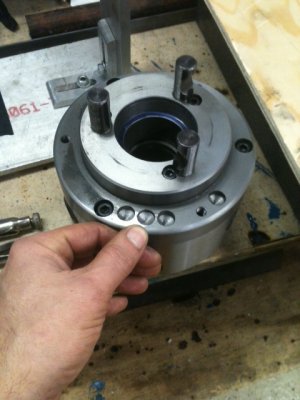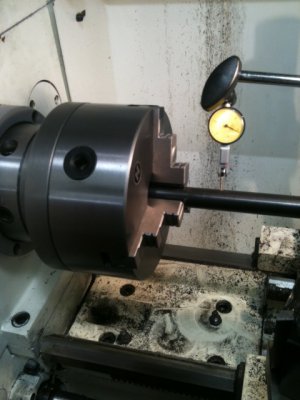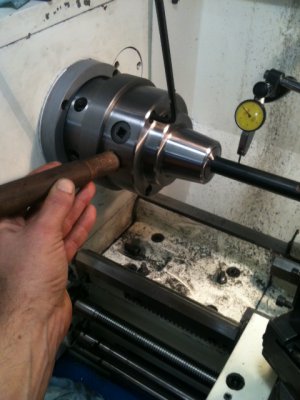Ok guys, I'm going to make this quick and talk about an easy-case balancing and a few thoughts about body/shaft centering. Will start a thread later on specifically for balancing and centering issues.
Safety Issues: When working on your chucks, make sure the jaws are safe, snug-up the bolts well during tests, work speeds up slowly -And don't leave keys or allen wrenches in the chuck. Remember, if they're not in your hand, they're on the table -but not in the chuck.
Also, this involves modifying your stuff... Don't do it if you're not comfortable or willing to take the risks.
Part 7:
By this time, your backplate fits well and centers about dead-on. You've checked the static balance of the backplate and chuck body and the opposite heavy sides have been put back together. When testing chucks on the machine, I leave the balance rod locked in the jaws of the chuck. Note that jaw position impacts the balance. Obviously, the further they are open, the more it impacts balance. I have weighed-out jaws on balance scales and they're far from uniform. It causes noticeable differences in balance but only with an empty chuck. If you're cutting big diameter stock, chuck balance will be impacted anyhow in ways you cannot predict. I have had situations whereby rotating the workpiece a little made a vibration go away. This is not idel and woudn't fly for high-end production/CNC machines but, we can get-away with it on manual homeshop stuff.
With the opposite heavy sides put back together, with any luck, the chuck has a more neutral balance than it did before. If you haven't already, tighten the bolts and test it on the lathe working the speeds from slow to fast. If you have little to no vibration at all speeds, quit while you're ahead and take the afternoon off. In the absence of a dynamic balance machine there's not much more you should do. If the chuck is really out of whack, it can shake the machine pretty good. -That's what the emergency stop switches are for!
If you have vibrations which you know will show-up on the workpiece, a small amount of correction can be made in one of two ways. If there's a gentle settling toward the heavy side, you can either drill divots in the backplate on the heavy side or, if you have a chuck that has internal cavities, you can internally add weight to the light side. I've done both methods with good success. I won't be discussing in this thread how I added internal weight.
When finding how much the chuck is off, I've found it helpful to tape coins to the light side. This will give you a ballpark idea of how much drilling to do. You need to wrap tape all the way around because of the oily chucks...
One thing to note: A chuck that is perfectly statically balanced could shake like hell when spun at-speed. -Dynamic imbalance rears it's ugly head -and sometimes at one speed but not at others. The point is this: Don't keep drilling divots until the static balance is perfect. No, instead, drill a little divot that helps the static balance a little then, go back and test at all speeds on the machine. If you have a very heavy chuck -too bad! Do the tests anyhow. Proceed and make adjustments conservatively. If you get to the point that the chuck is statically balanced but still shakes, read the next paragraph.
It's entirely possible you have a no-good chuck no matter what you do. -It's never happened to me or anyone I know but, from a mathematical and physical point of view, it's entirely possible. Of course, someone with the abilty to do dynamic balancing could identify the problem area(s) [note the plural]. I have a technique to approximate this but, it's not tried & true.
That's about it for balancing (as far as this thread goes). Here's a picture of divots in one of my back plates. Note that I spread them out a little. A Word of Caution About Divots: -Not that you should not be putting your hand on the chuck when it's spinning at any time -But, if you happen to get your pinky in that divot hole, you're going to have one finger shorter than the other. Drill the divots shallow. BTW: the same injury could occur due to the bolt-hole recesses. -Get it? -Don't put your hand on the chuck. I did it once and ended-up with 7 stitches (fortunately, I know how to suture myself but my wife had to tie the knots).
Anyhow, this chuck now balances very well at most speeds when not loaded with a workpiece. BTW: One of the reasons, I'm switching my machines to 3 phase is so I can tweak-out vibrations with frequency control.

Part 8 coming up -a quick thought about body vs shaft centering when mounting a chuck to a backplate.




